arboretum magazine
diversity and design power of annuals at the
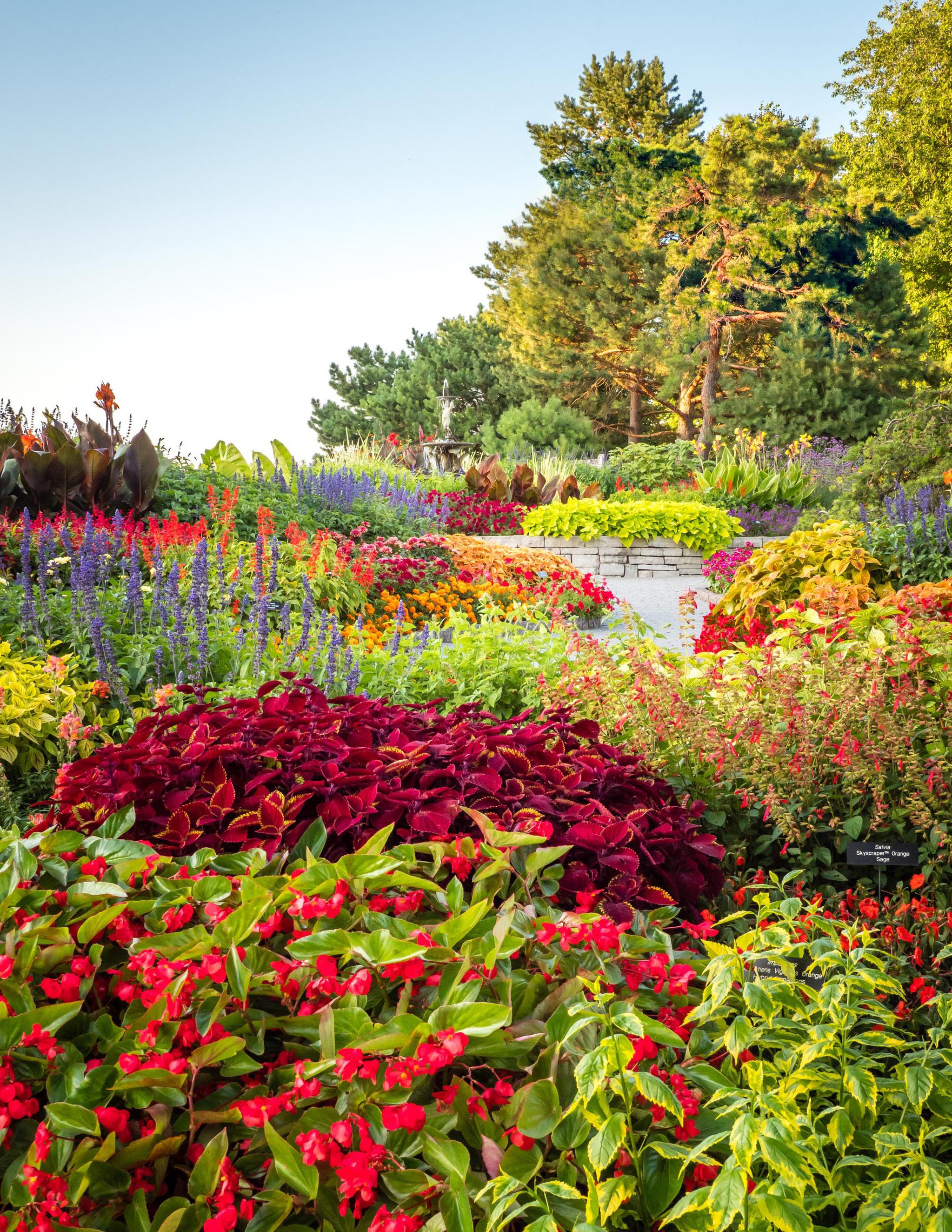
Discover the
Arboretum!
JUNE/JULY 2023
FROM THE DIRECTOR
ANDREW GAPINSKI
Welcome to the beauty of late spring at the Minnesota Landscape Arboretum! I am overjoyed to be starting as Executive Director just as we are ushering in countless blooms and the excitement of the early growing season.
I could not be more thrilled to be back in the Midwest to join the Arboretum community — an institution I have admired since my early horticultural beginnings. The youngest of six children, I was born and raised on the southern end of Milwaukee County and have cherished memories of the museums, gardens and other cultural institutions that enriched and broadened my view of the world.
When I was 10 years old, my parents moved the family to the countryside northwest of Milwaukee into an 1842 farmhouse made of white oak timber. They purchased the rundown, two-story log home from the Wisconsin DNR with access to farmland, ponds, silos, chicken coop, and the rolling hills of the adjacent Kettle Moraine State Forest. We grew our first vegetable garden and a small orchard on the manure-enriched land — and my father, an
JUNE/JULY 2023, VOL. 42, NO. 3
artist, painted scenes from the landscape around us.
I was fortunate to attend a high school with courses in horticulture and natural resources. In the summers, I worked as a field hand for a field-grown perennial nursery — digging, dividing and potting hostas and daylilies and doing various landscaping side jobs. My family’s landscape included a collection of the Arboretum’s ‘Lights’ azaleas.
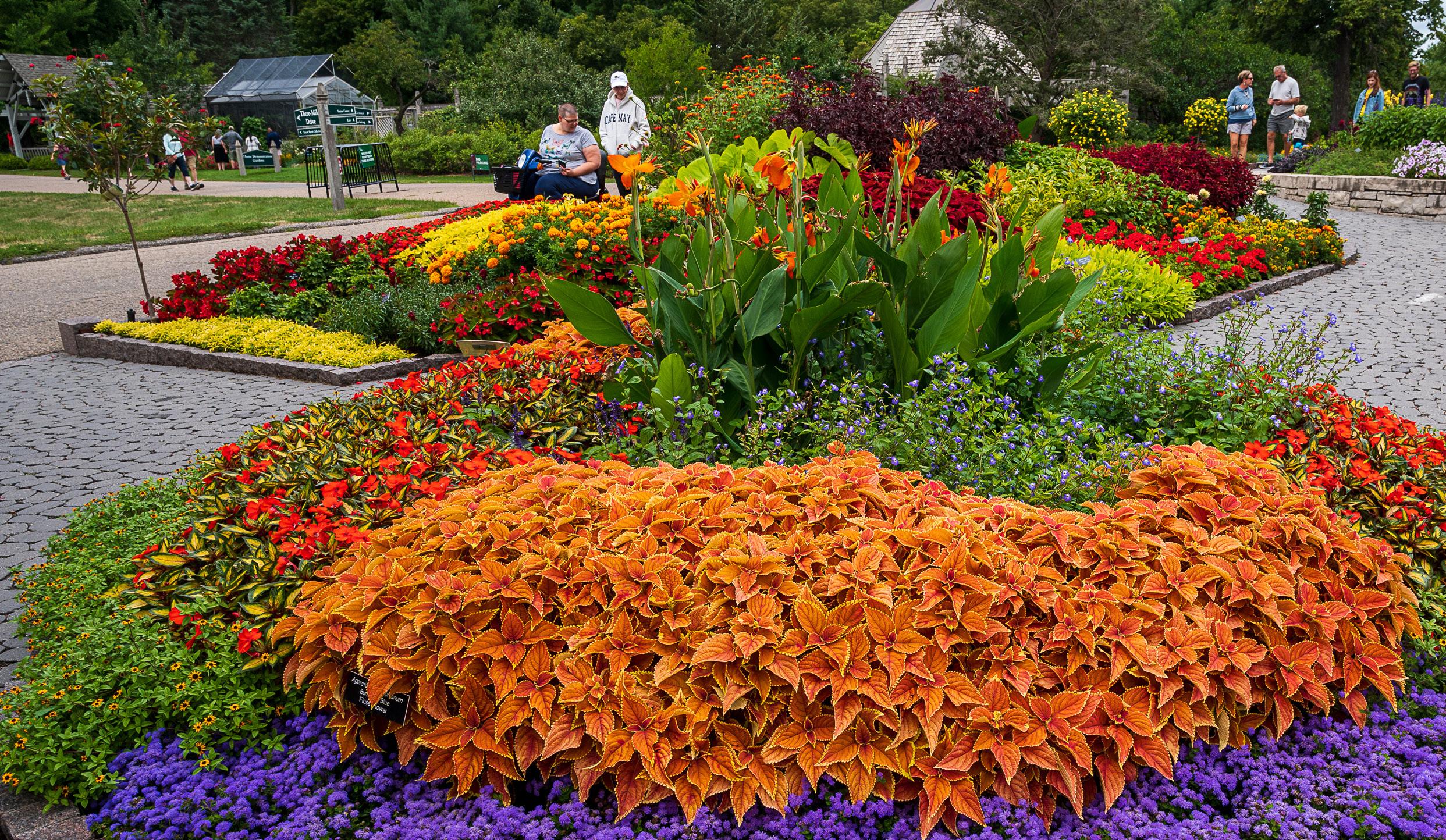
I went on to study horticulture at the University of Wisconsin-Madison and after graduation worked at the Morton Arboretum. I attended the University of Delaware for a master’s degree in public horticulture as part of the Longwood Graduate Program and worked as director of horticulture and curator of the Arboretum at Penn State. I spent the last decade caring for the collections and landscape — and traveling around the world — as director of horticulture for the Arnold Arboretum of Harvard University.
So now here I am, after two decades in horticulture, honored and deeply humbled to work alongside the Arboretum’s 200 full-time, part-time and seasonal employees and nearly 1,000 volunteers in the stewardship of the Arboretum’s collections, gardens and programs, providing windows of opportunity for all to discover and care for the natural and cultivated world around us.
I am so grateful for the warm welcome that I have received and for your continued involvement in the work of the Arboretum — your support matters more than ever! I look forward to meeting all of you in the coming months.
Minnesota Landscape Arboretum Magazine is published six times a year by the Minnesota Landscape Arboretum. The Arboretum is part of the College of Food, Agricultural and Natural Resource Sciences (CFANS) at the University of Minnesota. The magazine is a benefit of Arboretum membership. To request a copy of this publication in an alternate format, please call 612-301-1257.
© 2023 Regents of the University of Minnesota. All rights reserved. The University of Minnesota is an equal opportunity educator and employer.
Elise Bremer, Editor
Brenda Drake Lesch, Art Director
Andrew Gapinski, Executive Director
Alan Branhagen, Director of Operations
Timothy S. Kenny, Director of Education

Susan Taylor, Ph.D., Director of Advancement
Matthew Clark, Ph.D., Director of Research
Tom Lany, Marketing, Communications & PR Manager
Glenn Stolar, President, Arboretum Foundation arb.umn.edu 612-624-2200 arbinfo@umn.edu
| ARBORETUM MAGAZINE // JUNE • JULY 2023 2
Cover photo by Sara Pace
Photo by Todd Mulvihill
In the spring, the Arboretum’s annual gardens are known for their 40,000 plus tulips. But come June, a new adventure begins with thousands of annuals that grow into a riot of color, delightful flower forms, scents and ideas for home gardeners that lasts all season long!

Longtime Arboretum Horticulturist and Annual Garden designer Duane Otto said the Arboretum's 2023 design theme of embracing diversity will continue into the summer annual beds, showcasing a surprising array of hues, not just from blossoms, but also from foliage in varying shapes, sizes, textures and heights.
This year, visitors will experience a rainbow of colors from salvia, snapdragons and celosia — to name a few, chosen for their spike flower forms — and 6-foot-tall, bright-yellow popcorn cassia, which smells a bit like popcorn!
SEASONAL BEAUTY
Plants chosen for their eye-catching foliage will include coleus in an array of heights and hues; parsley as an edible-border plant; Hibiscus ‘Mahogany Splendor’ for its reddish-purple leaves; and elephant ears for their tropical flair.
Otto envisions his final garden designs like scenes or pictures and then hopes that weather will allow all the plants to reach their full potential.
“I’m trying to create a perfect photo op for visitors,” Otto said. “I come up with the plan and style, and I enjoy watching how it all comes together to create the end result.”
Otto uses hundreds of types of annuals in his designs for the main Annual Garden displays; the dramatic entrance garden on Highway 5; the Gatehouse gardens; the terrace gardens at the Oswald Visitor Center; the flagpole garden; the sidewalk garden that leads visitors to the Snyder Building; and the Snyder courtyard annual plantings. Then numerous u
ARBORETUM MAGAZINE // JUNE • JULY 2023 | 3
SARAH JACKSON • PR / MEDIA SPECIALIST
Photo by Jason Boudreau-Landis
The Annual Garden at the Arboretum is planted in June and continues its show into fall.
Arboretum staff and volunteers painstakingly plant and maintain the gardens from summer to fall with watering, weeding and deadheading.
In some of the beds, Otto employs a creative use of repetition in his designs. In the sidewalk garden, for example, visitors will notice a pattern of lovely, back-row plants — apricot-flowered ‘Whithelm Pride’ canna; ‘Lime Green’ nicotiana; a compact ‘Pink Lady’ cleome from the Clio series; and tall-flowering Verbena bonariensis ‘Buenos Aires’.
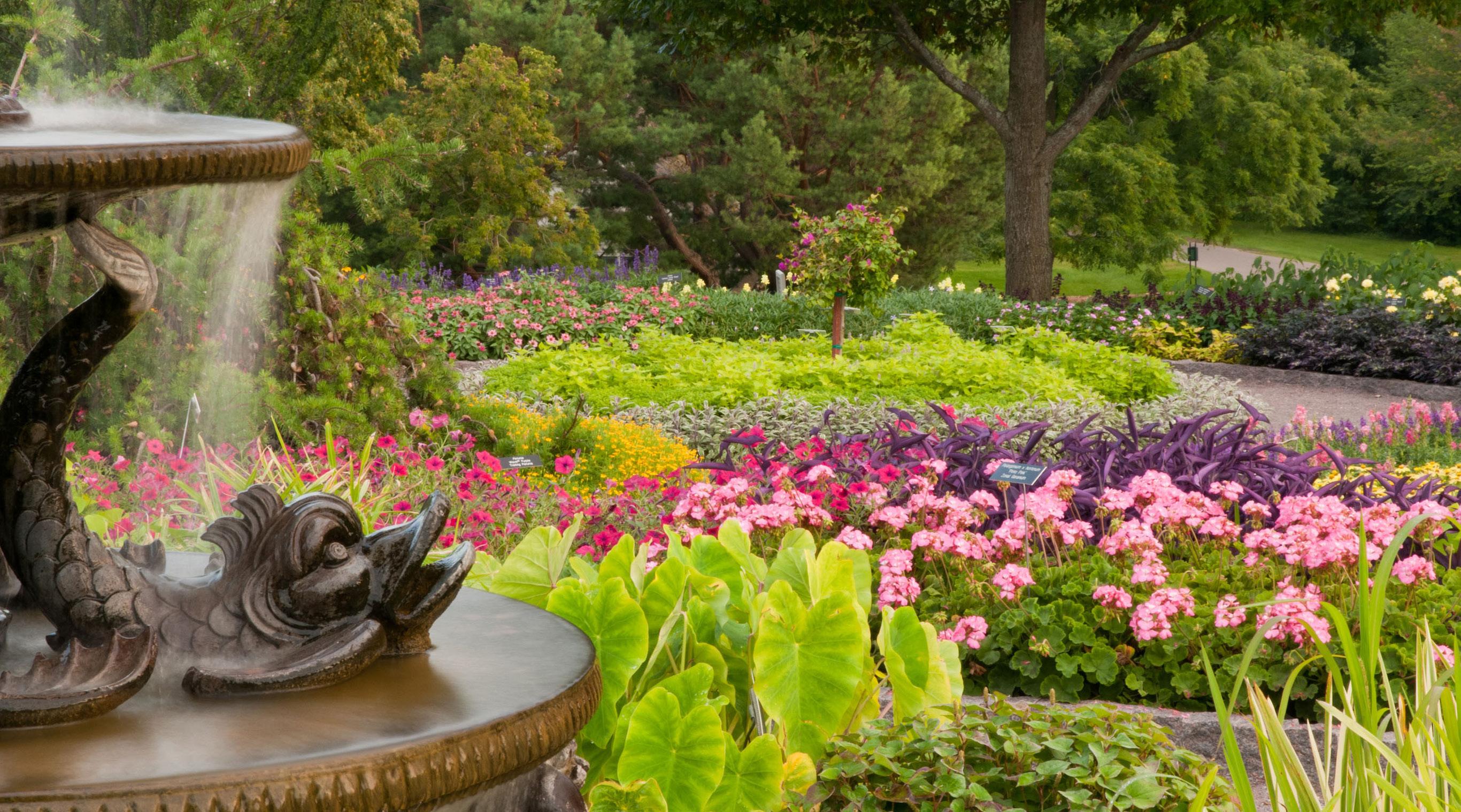
The annuals Otto uses in the display designs are grown in Arboretum greenhouses, started from plugs or seeds. The plants must literally stand up to months of conditions that range from chilly to sweltering and droughty to drenched. That means some cool-season plants, such
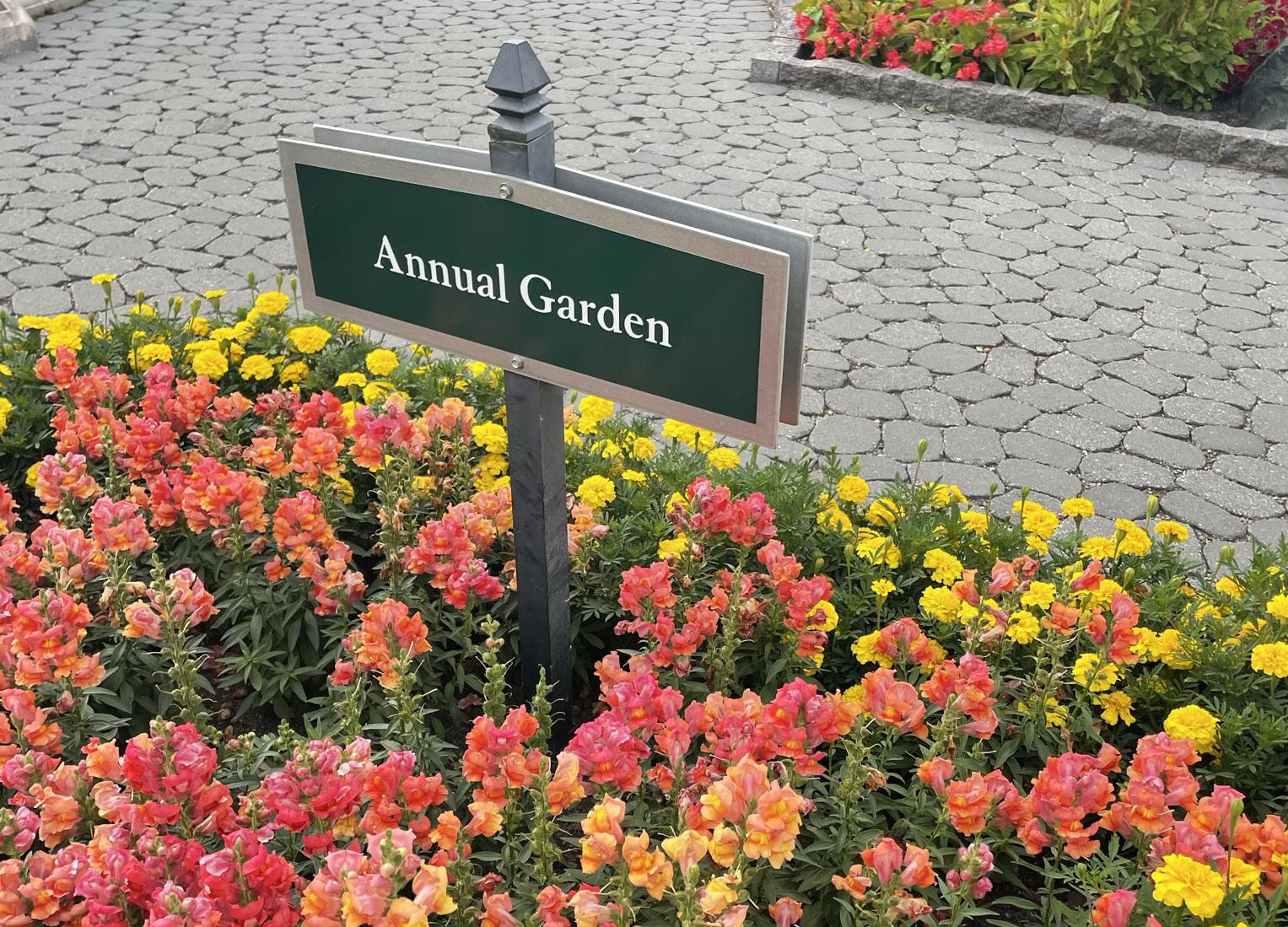
as stocks (Matthiola incana) aren’t on the annual list.
“You can’t use certain plants that are disease prone or that need a lot of staking,” Otto said. “I choose durable plants that will make it from beginning to end.”
Otto loves making new discoveries every year — something he hopes visitors can enjoy, too.
“You can always improve on what you do each year by taking notes,” he said. “Every season you can learn more and do a better job.”
More than 30 years of Otto's garden designs are archived in Andersen Horticultural Library (Snyder Building) and are also available at z.umn.edu/ArbGardenPlans.
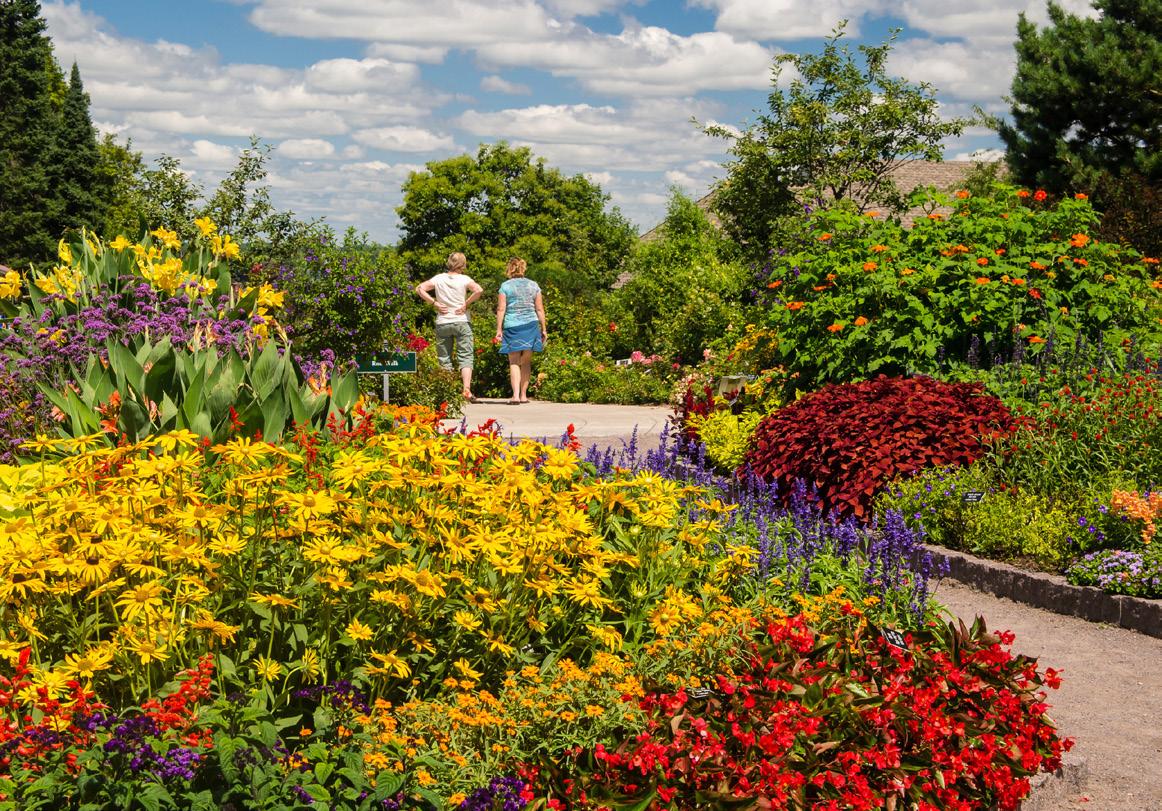
| ARBORETUM MAGAZINE // JUNE • JULY 2023 4 SEASONAL BEAUTY
Colorful foliage and flowers of varying heights and textures put on a show every year in the Arboretum Annual Garden.
Photos by Mark MacLennan (top and bottom right) and Sarah Jackson (bottom left)
ALAN BRANHAGEN • DIRECTOR OF OPERATIONS
Two large native shrubs really shine on the long summer days of June and into July—American elderberry whose large, lacey white flower clusters shimmer all day and glow into the night, and red-berried elder whose brilliant red berries ripen at this same time as its cousin blooms.

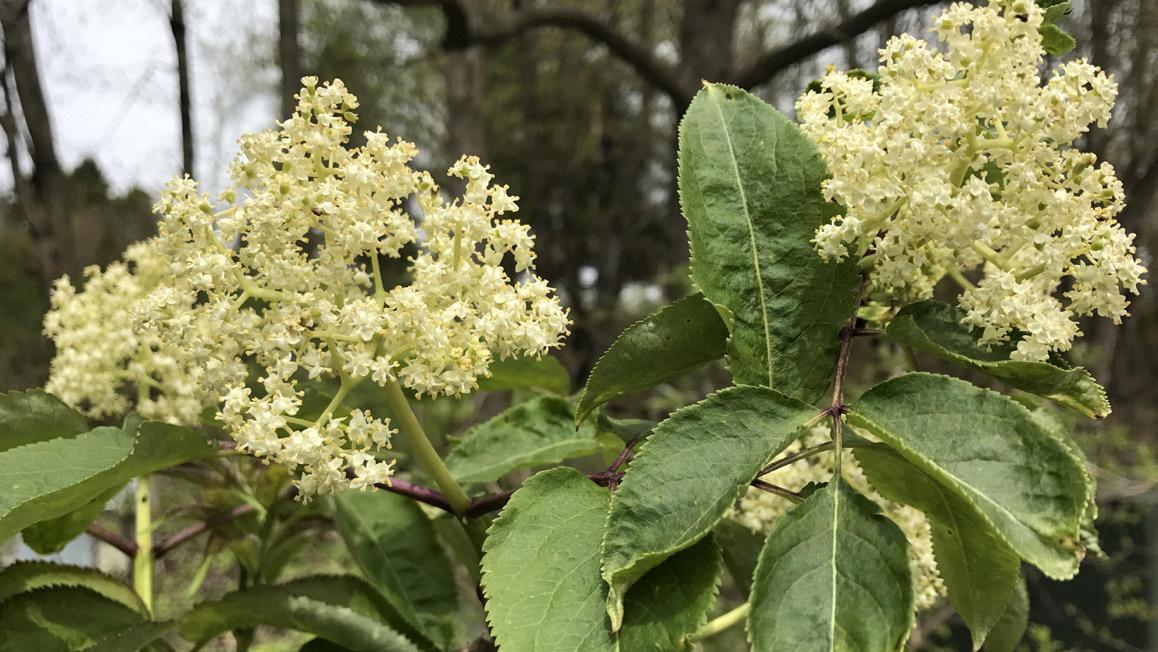
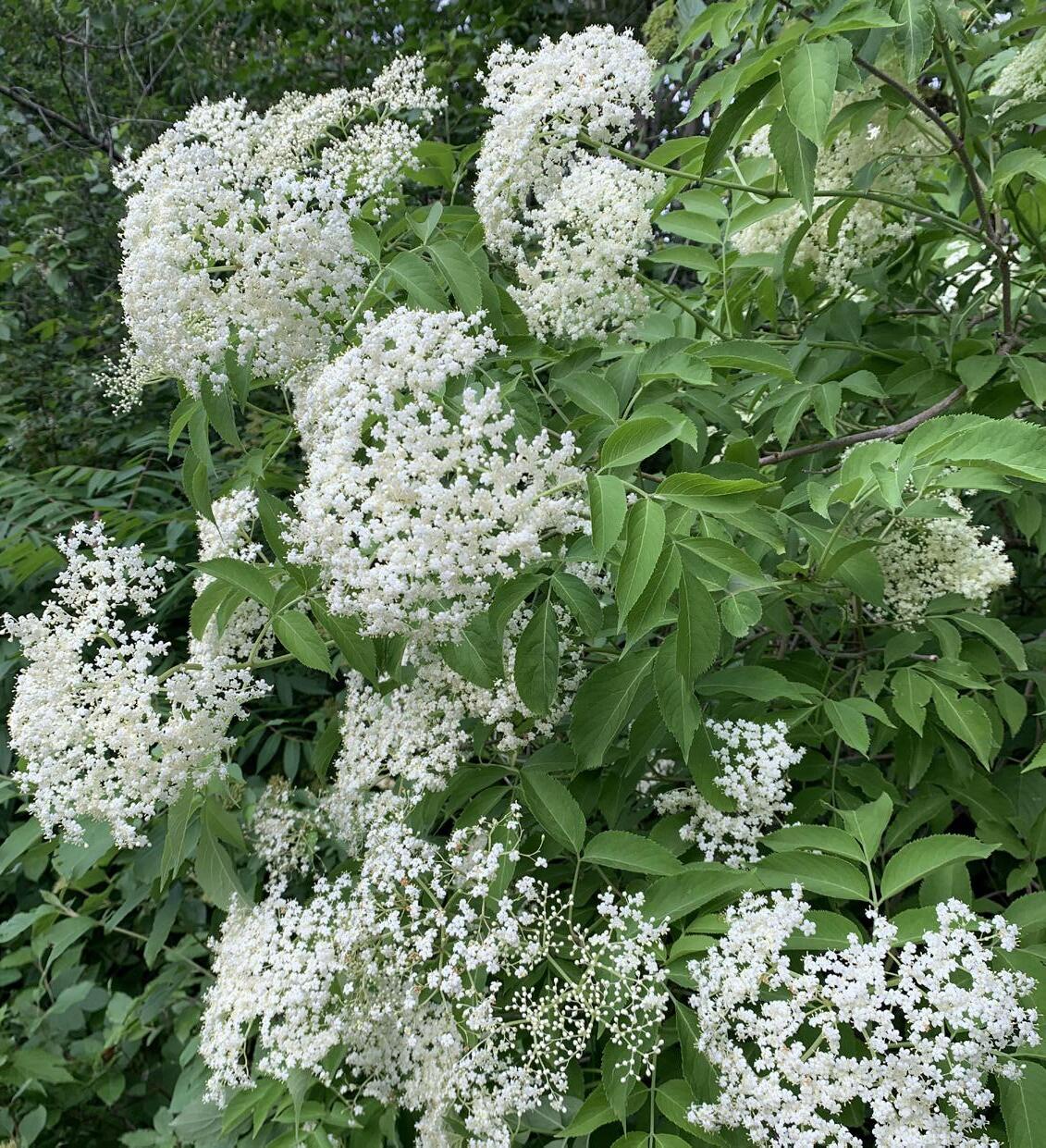
We’ll start with the red-berried elder (Sambucus pubens or S. racemosa if you lump it with the European species), a denizen of sheltered woodlands which leafs out very early and blooms shortly thereafter. The flowers in April or May are cream colored and followed by fruit among the first to ripen around the summer solstice. The ripe fruits are brilliant red, contrasting with the greens of the season. This striking color advertises the fruit for birds (everything from gray catbirds to rose-breasted grosbeaks) to consume and spread their seeds.
American elder (Sambucus canadensis) is closely related and is also early to leaf out but it takes its time to come into bloom. It usually starts to flower around the summer solstice when few shrubs are in bloom. The little flowers are massed in foot-wide flat clusters and the tiny flower buds are as pretty as the flowers: a galaxy of stars or a lace
doily opening into a frothy mass of white — pollinated by a plethora of beneficial insects. The flower clusters can be dipped in batter and fried as a down-home delicacy. Beware: Don’t eat the stems or any other part of the plant besides the ripe fruits!
Fruits on American elder don’t ripen until late summer and into fall and are renowned as a super food that makes wonderful preserves. I always sample a few off plants, though they’re not particularly tasty until they’ve been sugared up into jellies or syrups.
Both these shrubs are more highly prized in foreign gardens than they are in their homeland. Neither are formal garden plants, and American elderberry is wildly variable — some growing into an almost tree-like shrub or suckering into a thicket. They are important in natural, edible or permaculture landscapes. Both are native and planted at the Arboretum and you can’t miss them growing around the property, sometimes adjacent to each other where they create a stunning sight. Search for Sambucus at arb.umn.edu/plant-finder to find example sites, including the Bailey Shrub Walk, Green Heron Trail and Farm at the Arb, among others.

ARBORETUM MAGAZINE // JUNE • JULY 2023 | 5 HORTICULTURE
American elder (left, middle) and red-berried elder (top and bottom right) provide flowers to attract pollinators and berries to bring in birds.
Photos by Alan Branhagen
NATURE FOCUS
MATT SCHUTH • NATURALIST
In May the marshlands become a thick mass of vegetation with fresh green cattails and sedges emerging among the previous year’s vegetation, whose sturdy stalks have withstood the ravages of the bitter cold and snow of winter. Some of the chocolate-brown “Pronto Pup” seed heads, where cattail moth caterpillars live, hang loosely. The caterpillars survive by forming a network of seed fluff insulating them from the freezing temperatures.
Shiny, buttery-yellow marsh marigolds often grow around the marshland edges, but the persistent witchity-witchity-witchity-wit call of the common yellowthroat warbler is what grabs our attention. Both the male and female yellowthroat have a distinctive yellow throat, but males have a black facial mask and are sometimes called the
“yellow bandit.” Maybe instead of calling him a bandit we should think of him as the masked man, the Lone Ranger. Research has shown that the black mask is more important in claiming and defending territory from other males than it is for attracting females.
Even though yellowthroats most often inhabit wet areas, they will also inhabit drier areas wherever dense vegetation is available. Because of their habitat flexibility, they are thought to be the most numerous warbler species in the Americas. Thus, the name common yellowthroat is a fitting moniker for them.
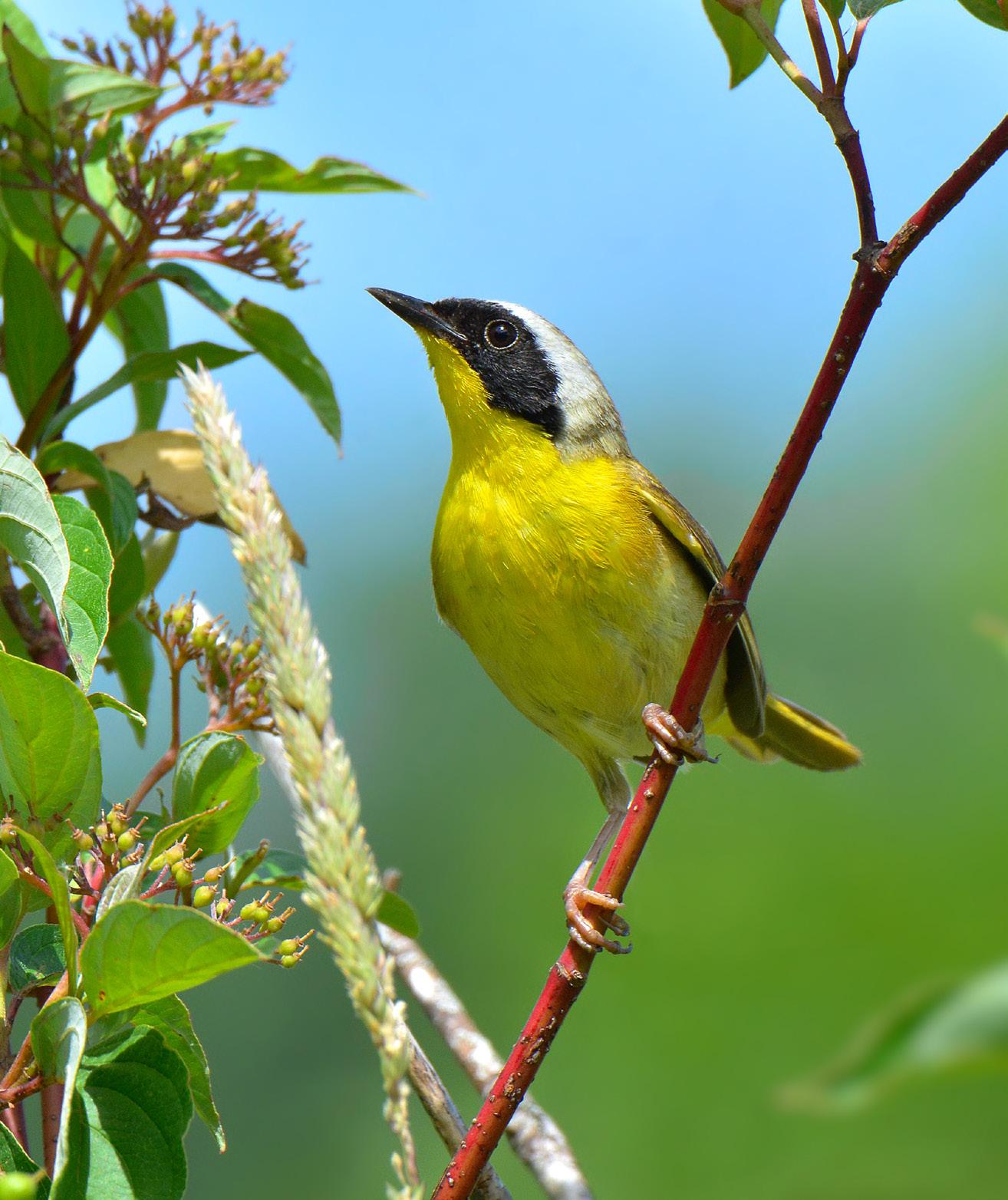
Yellowthroats reside in lower, tangled groundlevel vegetation. Their genus name of Geothlypis means “earth finch,” so named because of their ground-dwelling habits. Males can be hard to see
even when singing — they are curious however and will often appear to check out any unusual sound. Females are usually only seen darting in and out of the thick undergrowth where they make their nests on thick mats near the ground. Brown-headed cowbirds are common yellowthroats' worst enemies as they parasitize about 40% of early nests.
The witchity-wit call of the common yellowthroat can be heard around the Arb at Green Heron Pond, the Iris Pond, Spring Peeper Meadow, the Prairie and at Lake Tamarack.
Dreaming of a group of warblers means happier days are coming. Seeing a yellow bird is a reminder of the joy and wonder of the natural world. Our common yellowthroat warbler embodies both of these symbols.
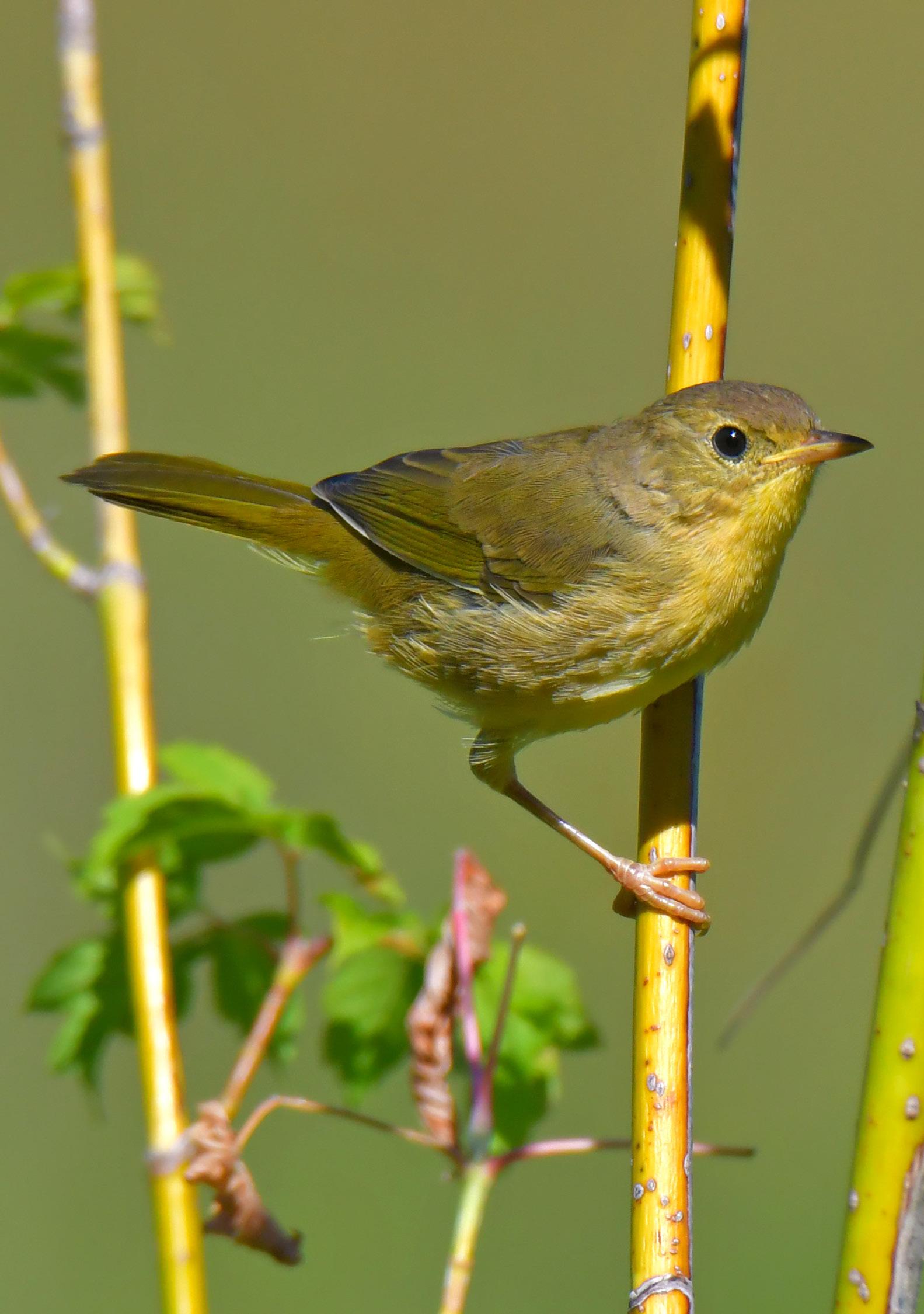
| ARBORETUM MAGAZINE // JUNE • JULY 2023 6
Female (left) and male common yellowthroats are known for their “witchity-wit” spring calls.
Photos by Nature by Travis Bonovsky
DAVID REMUCAL • DELORES E. ISAACSON CURATOR OF ENDANGERED PLANTS
The Arboretum’s Plant Conservation Program and the Department of Natural Resources have teamed up to form a new program called MN PlantWatch to track rare plant populations in the state. More than 300 plant species spread across the state are on Minnesota’s endangered species list. To effectively protect listed species, scientists and policy makers need to have an accurate picture of each species’ ongoing status.
The DNR’s Minnesota Biological Survey has compiled a large database on rare plant occurrences and the Bell Museum Herbarium has thousands of historic records of rare plants from around the state. Because of limited time and staff availability, many of the records for both organizations are decades old and we
don’t have a current idea how those populations are doing.
Generously funded by the Environment and Natural Resources Trust Fund, this program seeks to train and draw on citizen scientists to become rare plant watchers, leveraging the expertise already present at the Arboretum and the DNR to train, guide and organize.
These volunteers, certified by MN PlantWatch, will track down and survey old records of rare plants, set up annual monitoring for high-priority species or populations and even help collect seeds for the state’s long-term rare plant seedbank housed at the Arboretum. The program partners with groups like the Minnesota Native Plant Society and the Minnesota Master Naturalists, whose members are interested in
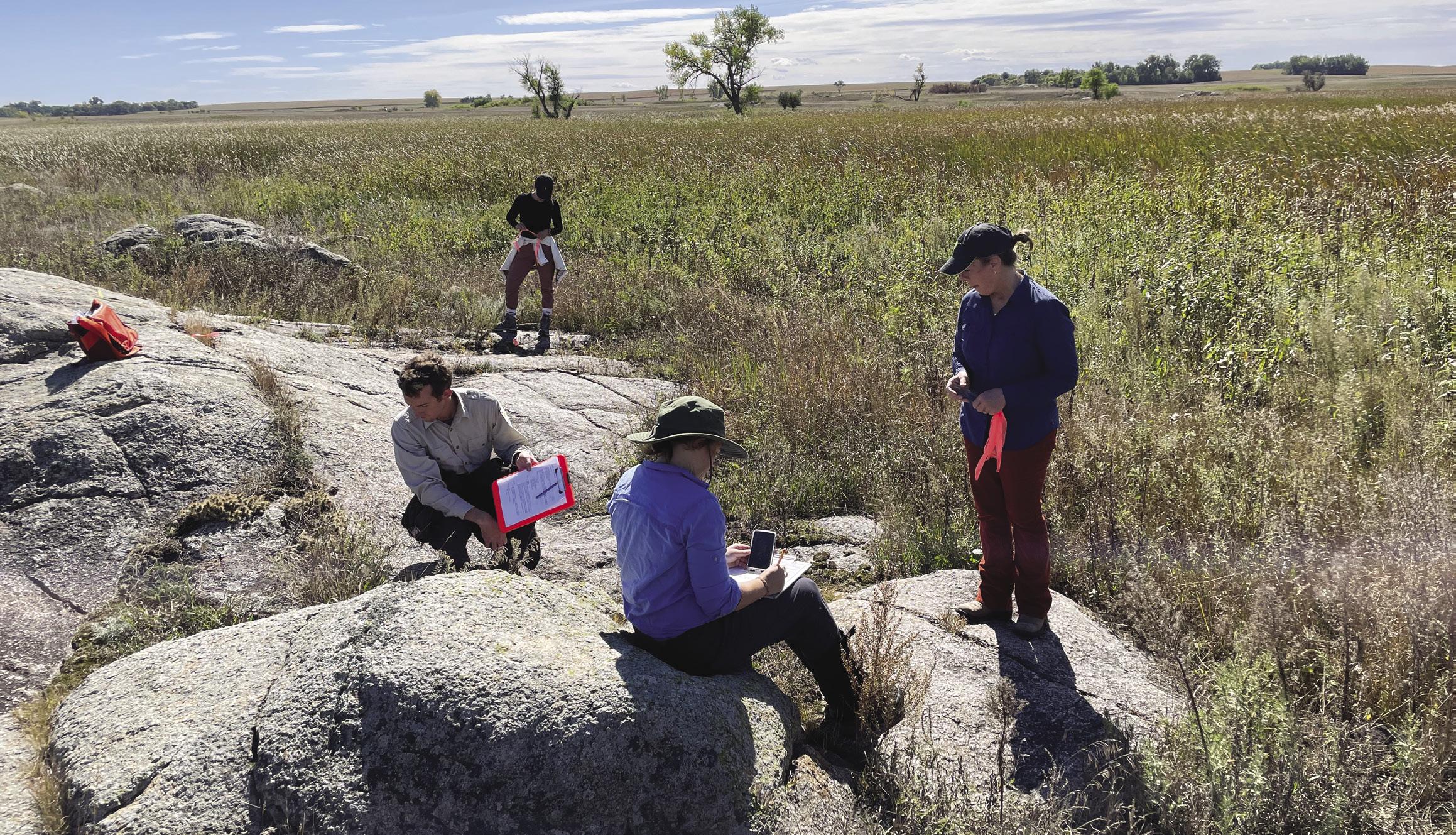
plants and conservation and have the motivation and skills to do something about it.
We expect this monitoring and survey data will lead to better understanding and decision making around rare species and accurately indicate how well any particular rare species is doing. The increased seed collection will further protect, in a very concrete way, the rare species in the state from immediate threats, such as land development, or long-term threats, such as climate change.
If you are interested in assisting in this program, we could use enthusiastic, plant-knowledgeable volunteers willing to travel in some hard-to-access parts of the state to lend a hand in this rare plant conservation effort. For more information visit arbconservation.umn.edu
ARBORETUM MAGAZINE // JUNE • JULY 2023 | 7
RESEARCH
A survey group records data at a rare plant species site in western Minnesota.
Connecting with plants
and nature is important for everyone, and experience in growing and cultivating plants provides an understanding of how to create healthy conditions that support personal and community growth, health, decision-making and wellbeing. The Arboretum’s Growing Good program works with community partners to provide access to these universal foundational needs. Our community collaborations support local youth while building on their interests and experience.
Youth in these programs enroll directly through existing community partner organizations, not through the Arboretum. Volunteer support comes from the Extension Master Gardener Program, Arboretum volunteers and community partners.
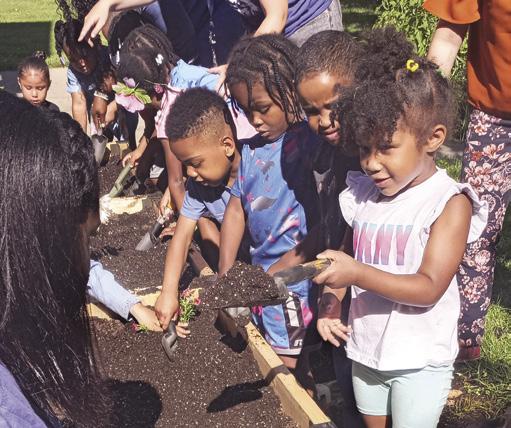
Financial support for these important programs comes from
grants, sponsorships, endowments and donations. Learn how to support the Growing Good program at arb.umn.edu/give or contact the Arboretum Development Team at 612-301-3220 or email arbgiving@umn.edu.
Fees from Arboretum memberships, admission tickets, classes and gift store purchases also support this work.
Children’s Garden in Residence for Ages 6-11
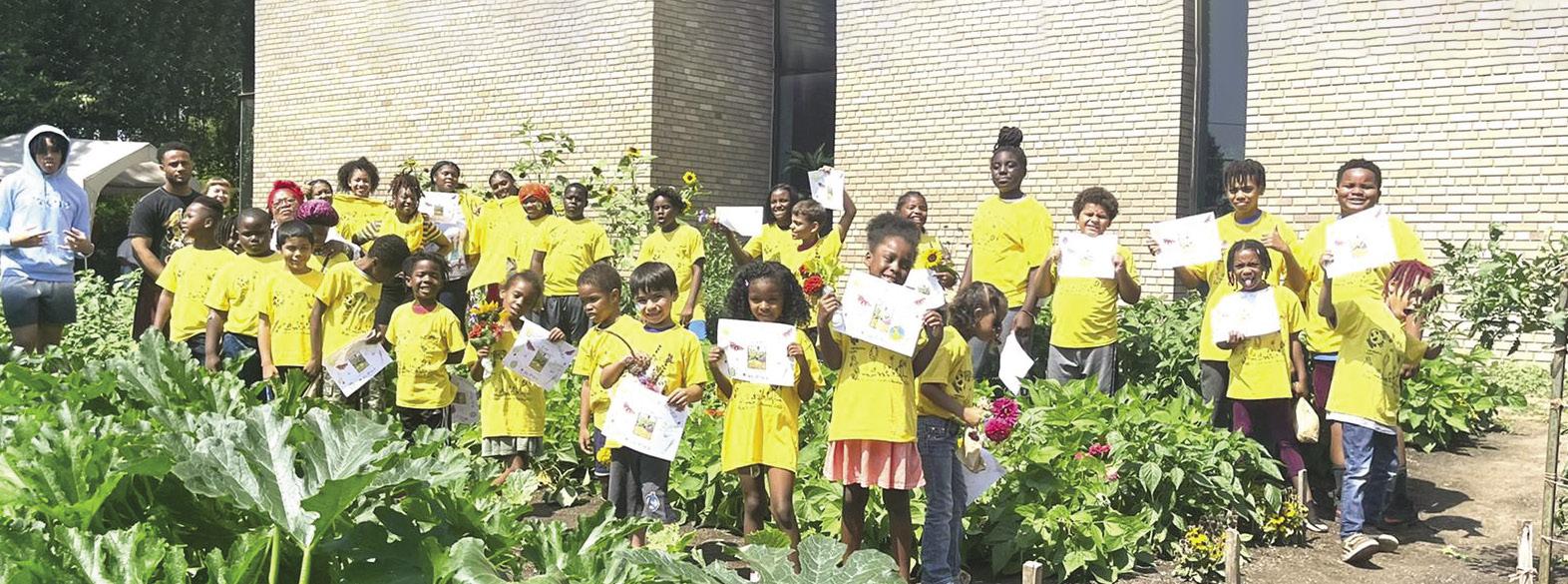

Weekly summer programs meet at community-based garden locations with local youth-serving partners like WE WIN Institute, PCYC and PICA Head Start. The Arboretum supplies instructors, curriculum, design, plant materials, tools and maintenance for participants to create their own garden plots that serve as living laboratories to explore hands-on plant science.
Ag & Aviation Day: June 29
Growing Good Food for Ages 12-15
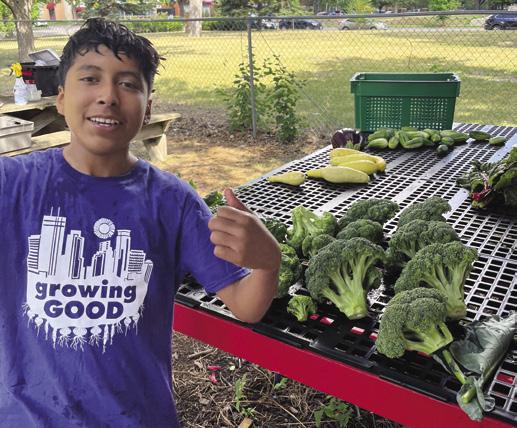
Paid internships empower youth to support food access and food justice through a partnership with Pillsbury United Communities. Participants learn how to grow and harvest vegetables while learning about local food systems. The vegetables that they grow are dedicated to community food access initiatives.
Growing to Lead for Ages 16-22
Paid internships explore topics related to growing food, plants, gardens, community leadership and technology. The 2023 projects include working with the Children’s Garden in Residence community gardens and a new program focused on the navigation of uncrewed aircraft systems (UAS) for agricultural applications.
Join the Growing to Lead interns at the Farm at the Arb for a celebration of ag and aviation history featuring food, music, presentations and special guest Gigi Coleman — great-niece of Bessie Coleman, the first Black woman to earn her pilot’s license. For more information visit arb.umn.edu/events/ag-aviation
| ARBORETUM MAGAZINE // JUNE • JULY 2023 8
The Arboretum’s Growing Good program provides outreach and engagement for young people in partnership with youth-serving organizations in Minneapolis and St. Paul.
LEARN AND DO
JILL LEENAY • EDUCATION
JEFF ISEMINGER • CONTRIBUTING WRITER
The name Van Sloun has intertwined with the Arboretum in powerful ways that have reverberated through its history, with no signs of slowing down. Brothers Dennis and Neil Van Sloun grew up in a house on the University of Minnesota Fruit Farm land at the intersection of Highways 5 and 41. Their father, Joe, worked at the Fruit Farm, now known as the Arboretum’s Horticultural Research Center (HRC).
Dennis’ children — Amy, Nancy and Joe — heard stories from him testifying to that intertwining. “Dad played pond hockey on today’s Wood Duck Pond, using willow branches as hockey sticks,” said Nancy. Neil studied horticulture in college and went on to found Sylvan Nursery in Massachusetts, one of the largest plant suppliers in New England.
The Arboretum has played a special role in
the extended Van Sloun family, from their early connection to the land, to memories of playing in the Arboretum creek before the Snyder Building was built, to taking classes at the Learning Center. Family members participated in the Arboretum’s Bud Break run-walk for many years, with Neil coming from Massachusetts to join the fun.
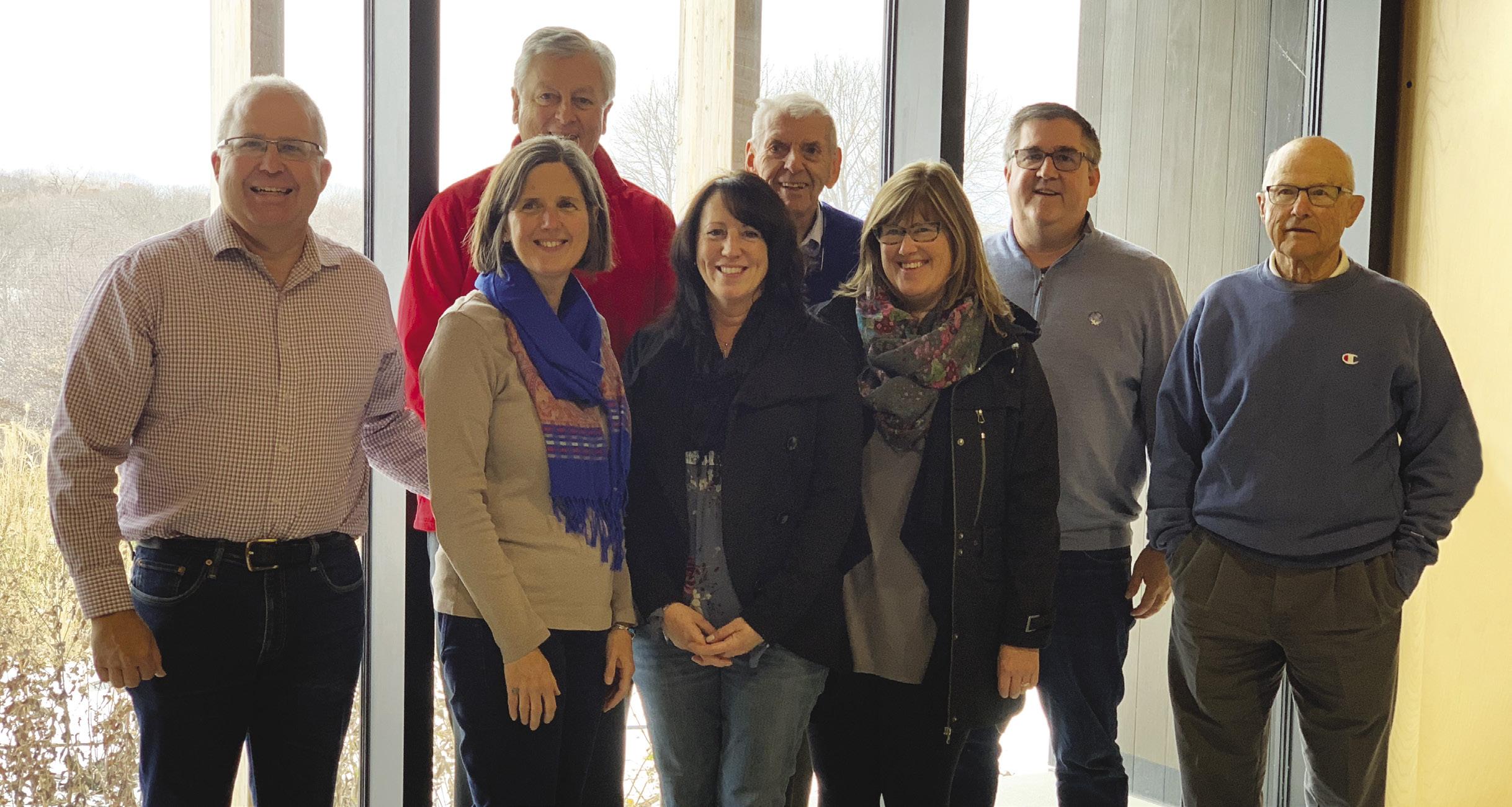
Here’s where their give-back story starts: In 1991, Neil and Sue Van Sloun formed a family foundation, and today their foundation’s mission aligns perfectly with many of the Arboretum’s strengths. The foundation’s trustees, which now include family and others, have used the foundation to help the Arboretum and its HRC in ways that span wide swaths of their operations and leave lasting impacts.
The foundation’s impact is seen across multiple Arboretum projects such as the Oswald Visitor Center, Bog Walk, Horticultural Operations
Headquarters, children’s education and care of the bees at the Tashjian Bee and Pollinator Discovery Center. They also have supported the HRC irrigation filter system and greenhouse modernization, as well as the Plant Conservation Program.
The Arboretum has also been strengthened by another bolster from the Van Slouns — endowment. “Endowment is a solid cornerstone of an organization,” said Joe Van Sloun, executive director of his family’s foundation. “It helps an institution like the Arboretum sustain and perpetuate itself into the future.”
Speaking of the future, the Van Slouns have their eye on it. “Climate change has already begun for our planet,” said Joe, “and the Arboretum is perfectly situated through its science and education strengths to help adapt to that challenge. Our family will be there to help.”
ARBORETUM MAGAZINE // JUNE • JULY 2023 | 9
THE JOY OF GIVING
Board members of the Van Sloun Foundation gathered for a photo at Tashjian Bee and Pollinator Discovery Center in 2018, including (front row): Joe Van Sloun, Nancy Van Sloun, Michelle Adesso and Amy Van Sloun; and (back row): David Titus, Everett Davis, Eric Strand and Dennis Van Sloun.
ART AT THE ARB
WENDY DEPAOLIS
• CURATOR OF ART AND SCULPTURE
Artist Kristen Lowe calls Minnesota home, but if she has a second home, you might say it’s the Minnesota Landscape Arboretum.
Renowned for her work locally — Minneapolis St. Paul Magazine called her “one of the most important artists working

in Minnesota” — Lowe has made a name for herself as an artist, filmmaker and art professor at Gustavus Adolphus College. Living within a few miles of the Arboretum, Lowe is a regular walker of the paths on the grounds at the Arb and nearby.
In fact, her highly anticipated exhibition
— “Ballad of the Blue Heron: The Carved Paintings of Kristen Lowe” opening May 27 in the Reedy Gallery at the Arboretum — is almost entirely inspired by the land and animals within a five-mile radius of the Arb.
Lowe has spent countless hours on the Arboretum grounds as an almost-daily

| ARBORETUM MAGAZINE // JUNE • JULY 2023 10
Arboretum visitors can view “Ballad of the Blue Heron” by artist Kristen Lowe in the Reedy Gallery starting May 27.
visitor, immersing herself in nature, capturing photographs and documenting experiences in sketches and even journaling her emotional reactions.
“When I walk a path at the Arboretum,” Lowe said, “I am often engulfed by the beauty and glory of the landscape, and then — out of the corner of my eye — a fox trots across the nearby glade, or a blue heron appears above my head. It’s shocking at times — nature’s way. These are the moments that get recorded in my mind.”
Lowe then takes all that mental and visual fodder and turns it into her signature works of art — large pieces, often 5 feet high and wide — using an innovative technique she developed that involves carving, drawing and painting.
“When I get back into my studio, I begin the work of transferring the experience — not just the objects — onto my wood pieces,” she said.
Starting with Shina basswood from Japan, a favorite among Japanese printmakers, Lowe lays down a base coat of paint. This gives each piece a luminous quality, allowing a finished work to appear as though it is coming out of the darkness. She then carves an abstract design with traditional woodworking tools, a nod to her Scandinavian heritage.
Next she adds charcoal, a medium she knows well, nestling sensitively rendered animals into the landscape — owls, herons, even the osprey as seen on the Arboretum’s osprey camera, as well as mammals.
Some of her pieces, such as the “Ballad of the Blue Heron” (pictured), are imbued with color from pastels, which are then sealed. When the viewer stands back to take in the entire image, it appears, as if by magic, that the grain of the wood is emanating light from within, giving a glow to a shimmering lake and a shine from a distant, high moon.
“These intense moments with nature stay with you,” Lowe said. “It is my goal to transfer it all into my art.”
See the show
“Ballad of the Blue Heron: The Carved Paintings of Kristen Lowe” | May 27-Aug. 20, 2023 | Reedy Gallery
Meet the artist: On June 17, join Kristen Lowe at 11 a.m. for a walk at the Arboretum revealing some of her sacred spots. At 1 p.m., attend an artist talk and reception in the Reedy Gallery.
Learn more at arb.umn.edu/art-galleries.
A new art exhibit is coming to the Arboretum. But it won’t be visible to the naked eye — that is, unless you have a smartphone and you know where to look.
The “Dakota Sacred Hoop Walk” is an augmented reality (AR) experience by Spirit Lake Dakota artist Marlena Myles. Myles, who is based in the Twin Cities but known nationally, launched the first stop on the walk at the Arboretum in 2022, sharing sacred concepts from Dakota culture — Grandmother Earth, the Four Winds and a woman named Wohpe, a spirit of harmony and peace.
It all began in the Harrison Sculpture Garden, where visitors used their smartphones to discover her digital art and audio, thanks to a collaboration with Pixel Farm, the makers of the Revelo AR app. That was “Stop 1: Highpoint.” This summer, Arboretum visitors can now experience audio and visuals on all five stops on the walk, starting June 25 with a special celebration featuring Native American food, arts, crafts, performances, storytelling and more.
“Stop 2: Arrival of Spring” sits at a cedar and maple tree duo. “Stop 3: Tree of Life” takes place at a majestic oak tree. “Stop 4: Whispering Roots” is nestled in a peaceful pine grove. “Stop 5: Hold Each Other Sacred” concludes the walk in the Ornamental Grass Collection at the “Kiciuzapi” sculpture by John Sterner, a member of the Rosebud Sioux Tribe and a Sicangu Lakota.
Myles likes the fact that her art needn’t alter the land, thanks to AR technology: “It allows us to be heard as Native people, while also allowing people

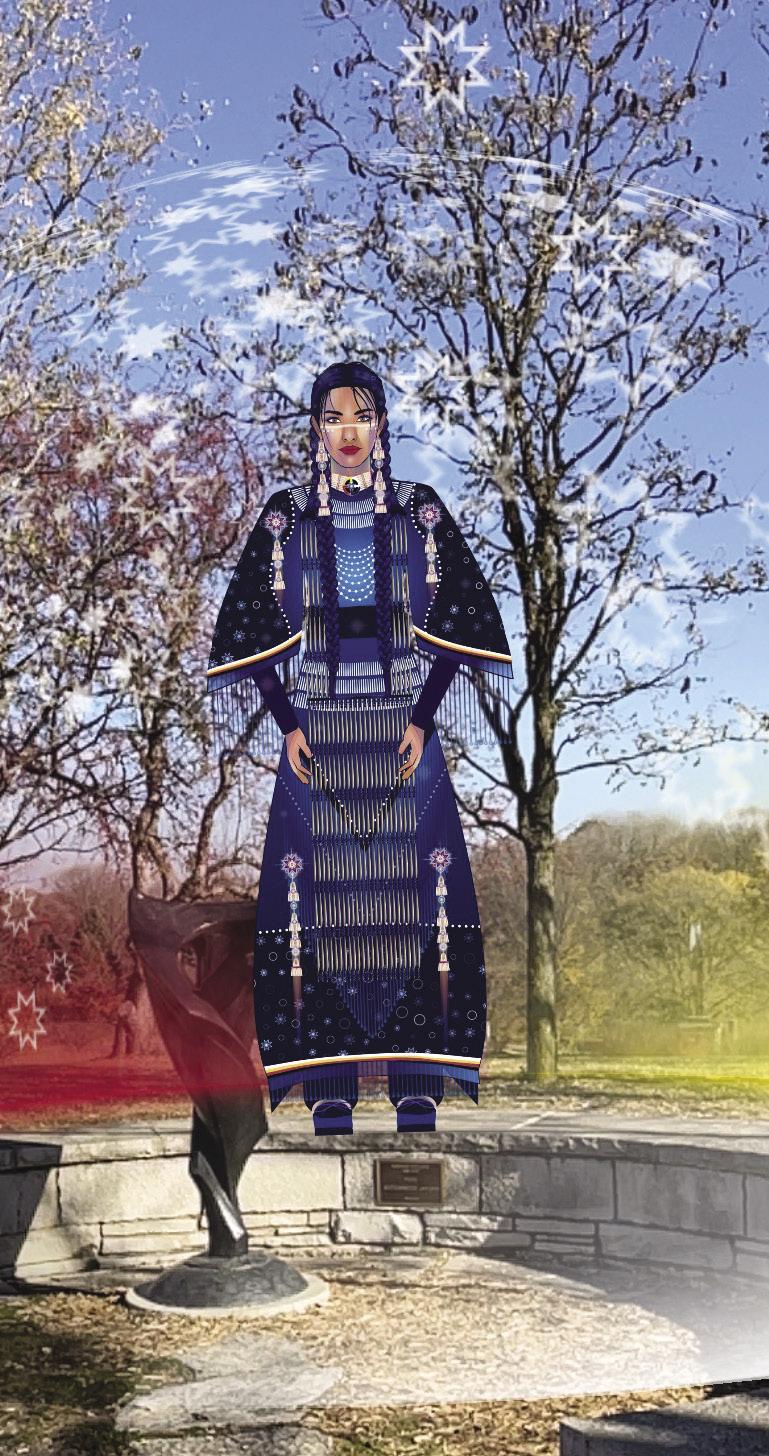
to see us in a modern light,” she said.
In the end, Myles said, those who download the app and experience this digital art walk will leave with a new understanding of Mitákuye Owás’iŋ, meaning, “All are related.”
Get tickets to the June 25 Dakota Sacred Hoop Walk celebration at arb.umn.edu/ sacredhoopwalk .
ARBORETUM MAGAZINE // JUNE • JULY 2023 | 11 ART AT THE ARB
SARAH JACKSON • PR / MEDIA SPECIALIST
“Wohpe” by Spirit Lake Dakota Artist Marlena Myles is part of an augmented reality installation opening June 25.
AUXILIARY QUILT RAFFLE
May 14-Oct. 7
The 2023 Arboretum Auxiliary fund-raising quilt—titled "Minnesota Woodlands"— features a whimsical collection of woodland creatures, flowers, animals and birds of Minnesota. It measures 59" x 75", and is on display in the Oswald Visitor Center Great Hall. Raffle tickets are $2 each. The drawing will be held in the Snyder Auditorium on Oct. 7 as part of the Auxiliary's Annual Harvest Sale. See arb.umn.edu/auxiliar y

BIKE THE ARB
June 10, 8
a.m.-Noon
See the Arboretum’s unique plant collections and specialty gardens on two wheels at the Arboretum’s third-annual Bike the Arb event! Cyclists of all ages and abilities are encouraged to bike to the Arb to get some exercise, experience nature and reduce their carbon footprint in the process. Ride your bike to the Arb and receive free admission. Register in advance to reserve your free admission pass at arb.umn.edu/bikethearb

STORY TIME
MUSIC IN THE GARDENS
Thursdays 6-7:30 p.m. and Sundays 1:30-3 p.m. Enjoy live music throughout the summer at the Ordway Picnic Shelter. Local bands and community groups will perform a wide range of musical styles. Bring a blanket or lawn chair for seating. This event is included with daily ticketed admission. See the lineup at arb.umn.edu/musicinthegardens.

June 30, July 28, 10:30 a.m.
Join us on the last Friday of each month for StoryTime in the Andersen Horticultural Library. We’ll celebrate plants and nature and foster a love for books and reading as we explore the library's vast collection of children’s books. StoryTime is recommended for ages 0-5, but all are welcome. Learn more at arb.umn.edu/events/librarystorytime
FIREFLY VIEWING NIGHTS
Thursday, Friday & Saturday evenings; June 22-24; June 29, 30 & July 1; July 6-8 8:30-10:30 p.m.
Experience the magic of summer nights at the Arb with hundreds of fireflies flashing through the sky! Marvel at the wonder of these glowing, winged beetles (also known as lightning bugs) and learn about these special creatures from local experts and Master Naturalists. Every week features a different nighttime creature that can also be spotted (or heard) during Firefly Viewing Nights! Cost is $5 members/$20 non-members. Register at arb.umn.edu/FireflyNights
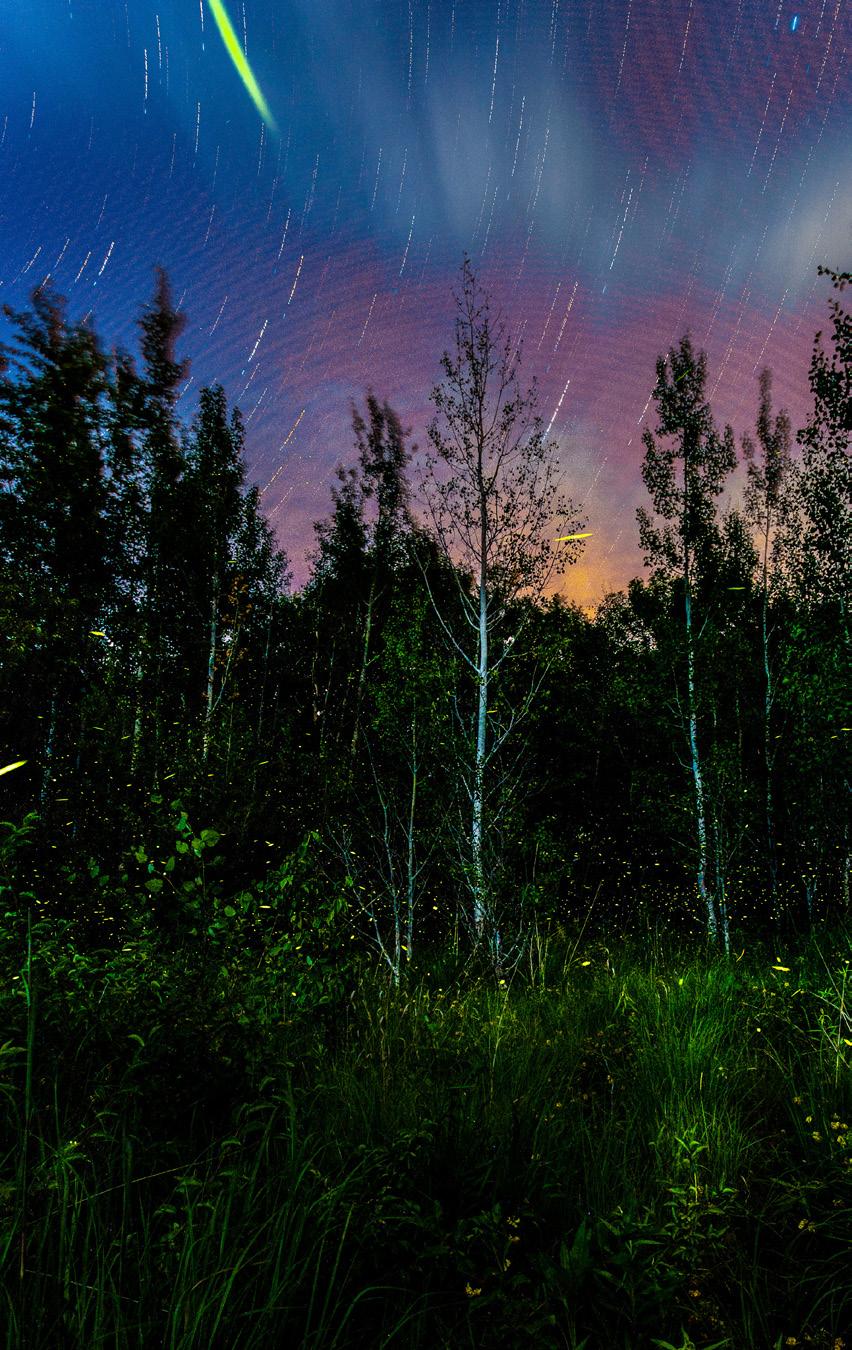
June 22-24 — Bats & Fireflies
June 29, 30 & July 1 — Owls & Fireflies
July 6-8 — Frogs & Fireflies
| ARBORETUM MAGAZINE // JUNE • JULY 2023 12
EVENTS
Photo by Don Olson
Photo by Jason Boudreau-Landis
YO GA
IN THE GARDENS
Complete your visit to the Arboretum with a summer session from this popular series. Registration is $5 per class for members and $20 per class for non-members and includes daily general admission. Get tickets (required) at arb.umn.edu/yoga
June 4, 10 a.m. — Bodyweight Sculpt in the Sculpture Garden
June 15, 6 p.m. — Yin & Sound Healing at the Oak & Nut Collection
June 29, 6 p.m. — Yoga Barre Fusion in the Sensory Garden

July 9, 10 a.m. — Slow Flow & Meditation in the Nelson Shrub Rose Garden
July 13, 6 p.m. — Gentle Flow & Meditation in the Sculpture Garden
July 23, 10 a.m. — T’ai Chi Chih at the Hedge Collection
FAMILY FUN AT THE FARM
June 24, July 15, Aug. 12, 10 a.m.-4 p.m. Bring your family and friends for fun, hands-on learning experiences at the Farm at the Arb!
• Meet Minnesota food growers and producers and learn about their work.
• Taste Minnesota through plant-to-plate cooking demonstrations and samples.
• Explore interactive exhibits, games and hands-on activities.
• Tour the Farm at the Arb crop plots, food gardens, orchards and more. Learn more at arb.umn.edu/events/familyfarmsaturdays
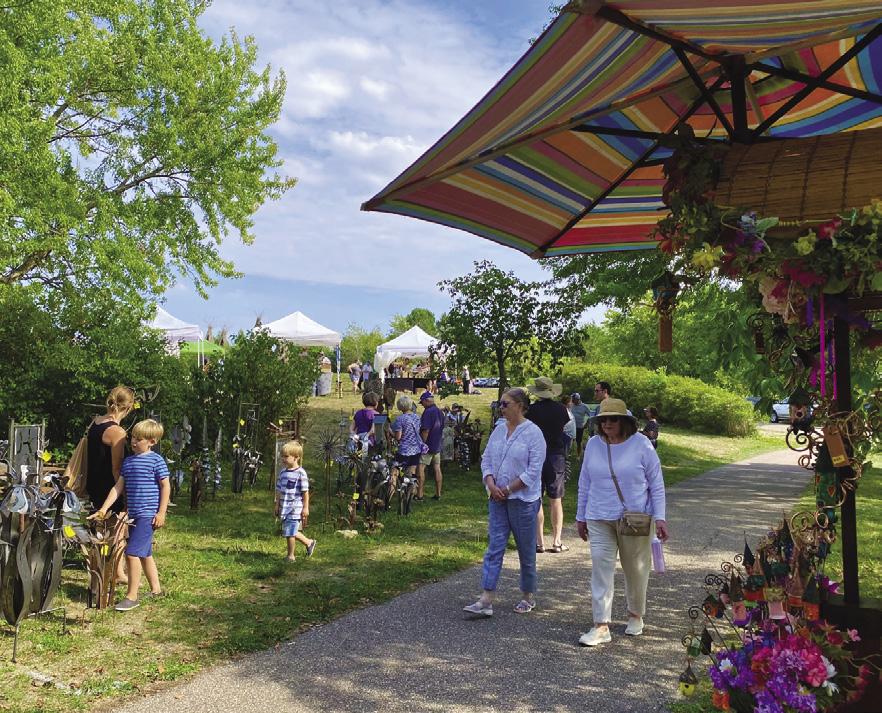
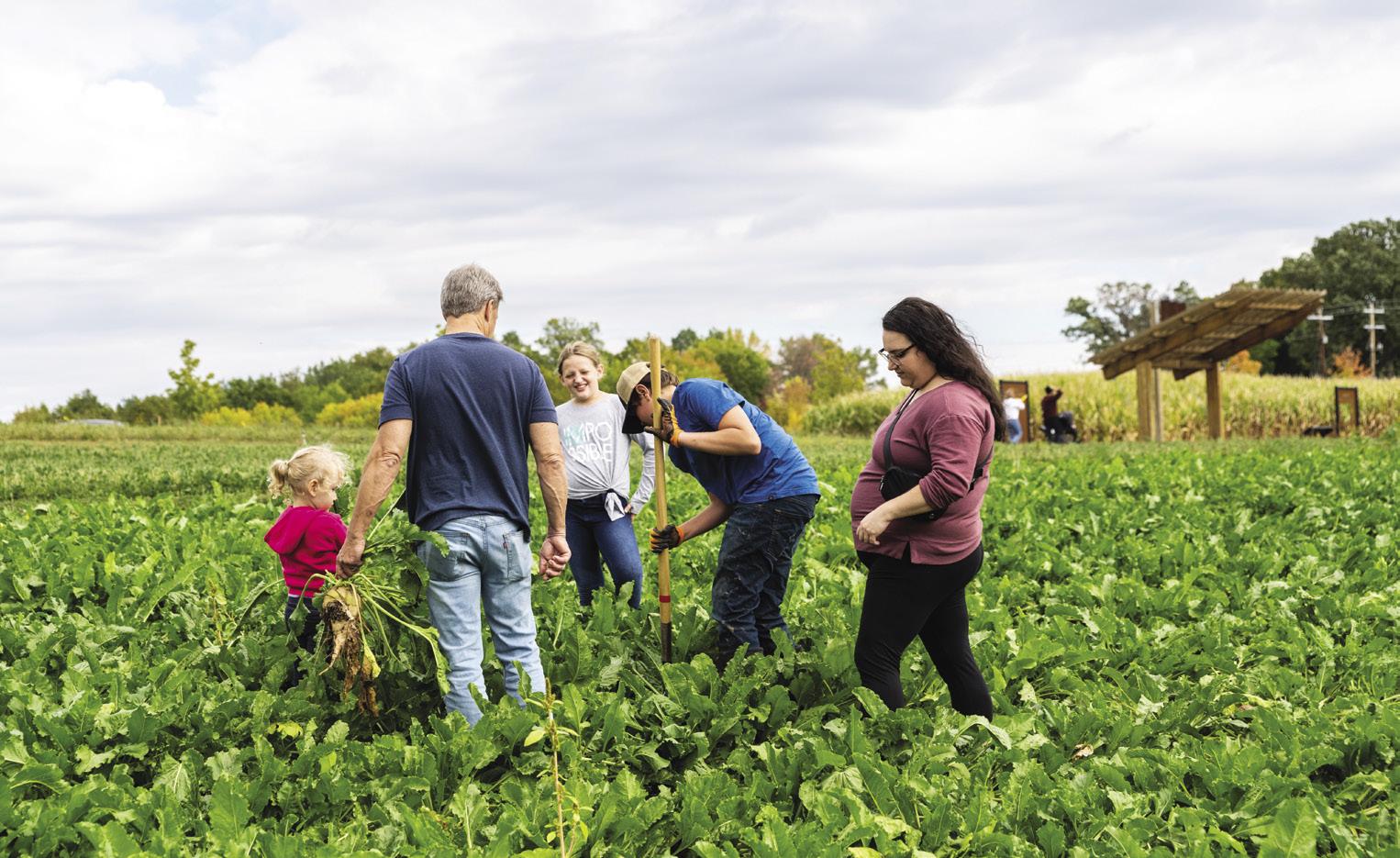
ART IN THE GARDENS
Aug. 18, 4-8 p.m. and Aug. 19-20, 10 a.m.-4 p.m.
SUMMER SOLSTICE YOGA RETREAT
June 24, 9 a.m.-3:45 p.m.
Relax your mind, body and spirit while embracing the height of the summer season at the Arboretum's 4th-annual Summer Solstice Yoga Retreat. Start the day off with a light breakfast in the Sensory Garden, followed by four different class rotations with a break for lunch. The retreat will close with a blissful yoga nidra session in the Harrison Sculpture Garden. Full and half-day retreat options, as well as a pre-purchased lunch, are available. Full-day registration cost is $45 members/$60 non-members and half-day $25 members/$40 non-members. Lunch can be added for $20. Register at arb.umn.edu/events/summeryogaretreat
Save the date: At this unique showcase of art and nature visitors and artists can mix, mingle, stroll, eat and shop. High-quality products include artisan foods, handmade jewelry, natureinspired art, and spa-worthy bath and body products and more. Visitors will enjoy live music and access to a special food tent. Learn more at arb.umn.edu/events/artinthegardens
ARB GLASS PUMPKIN PATCH
Sept. 15-17
Save to the date to browse through more than 5,000 handblown glass pumpkins and glass garden art made by award-winning, professional glass artists presented by the Arboretum Auxiliary. Proceeds support the Arboretum and the artists. Learn more at arb.umn.edu/auxiliary-glass-pumpkin-patch

ARBORETUM MAGAZINE // JUNE • JULY 2023 | 13
Photo by Katie Knapp
Photo by Sara Pace
EVENTS
Sip, snack and stroll through the gardens Wednesday, July 26 at Taste & Toast, an after-hours celebration of fresh, local cuisine, regional wine and beer. Live music sets the stage for tastings from local and regional chefs, restaurants and farmers, as well as light bites from Minnesota wineries, breweries and the Arboretum’s Horticultural Research Center.
Check out the full lineup and reserve your ticket at arb.umn.edu/events/ taste-and-toast. Space is limited.
PRESENTING SPONSORS:
The Gala in the Gardens is back at the Farm at the Arb on Thursday, June 15. Hosted by the Minnesota Landscape Arboretum Foundation Board of Trustees, the gala is the Arboretum’s signature annual fundraising event.
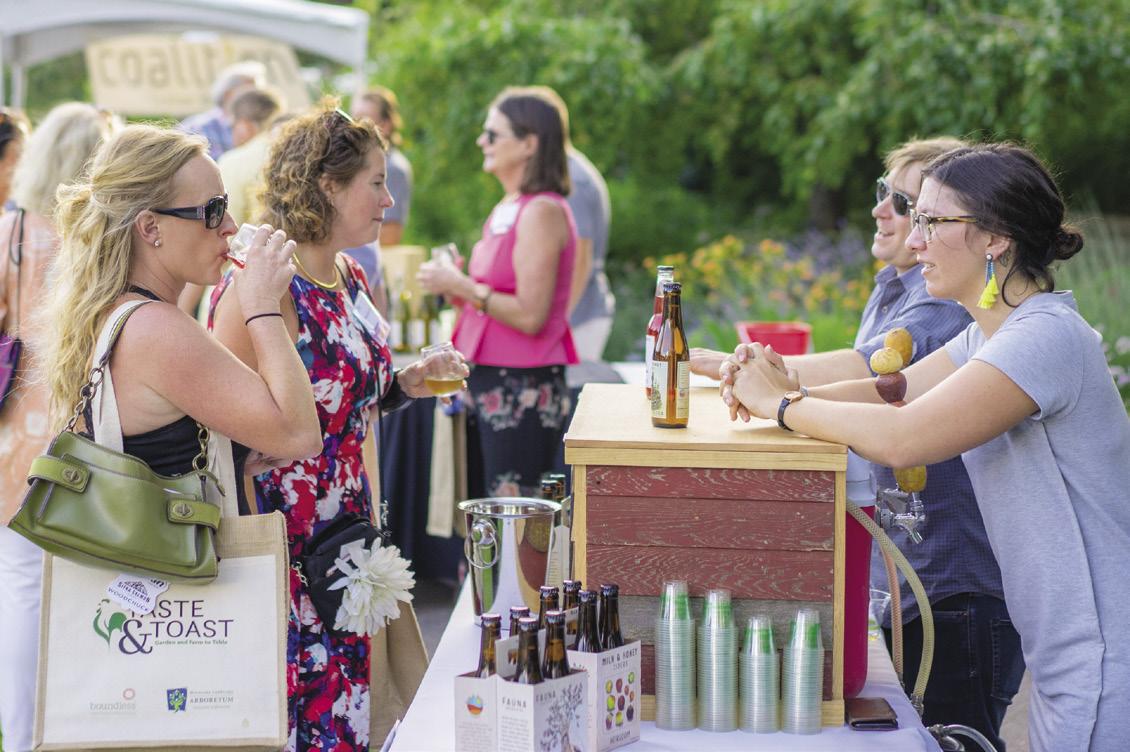
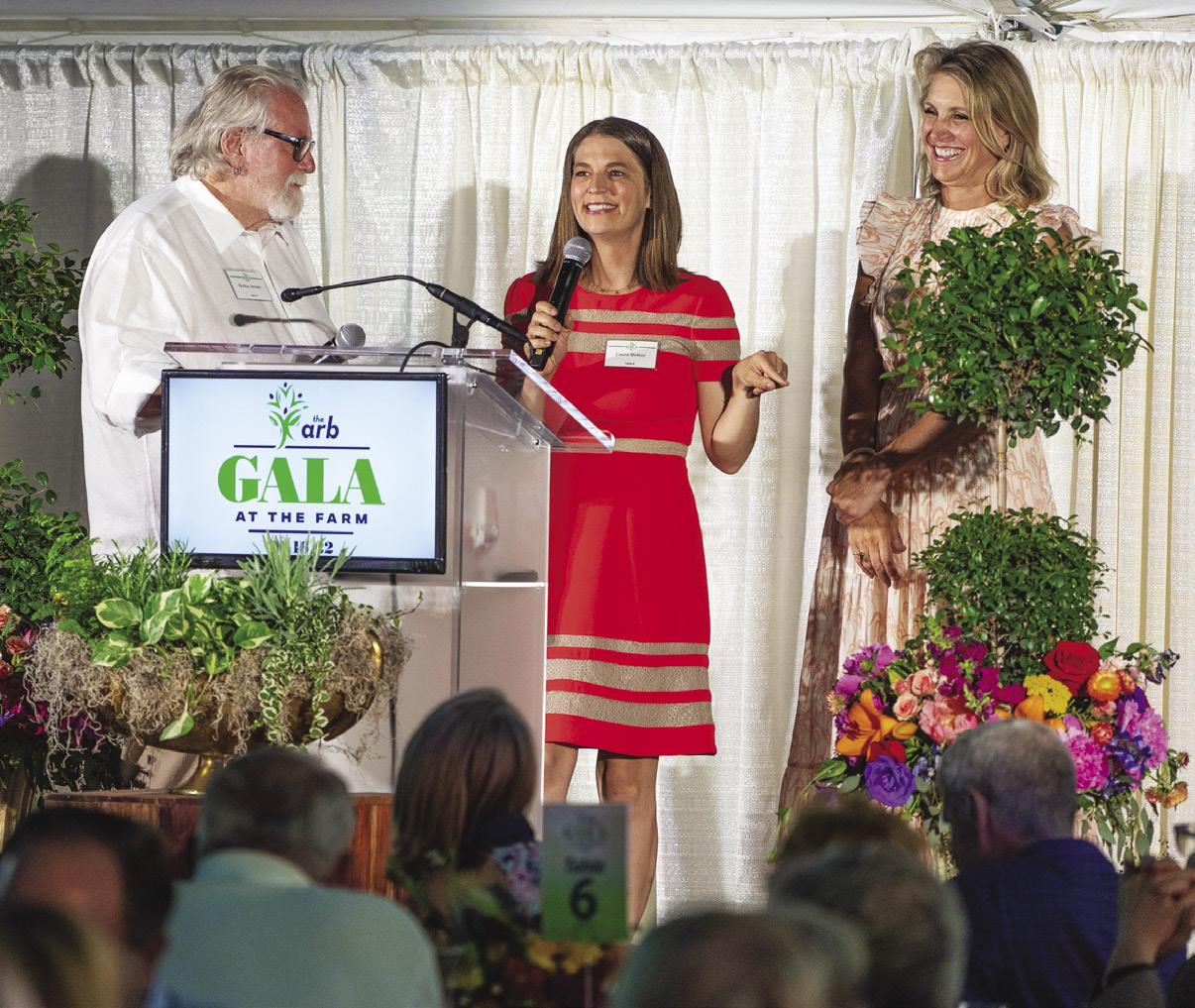


Join us for an inspiring evening with emcee Belinda Jensen, KARE 11’s Chief Meteorologist. Together, we’ll celebrate the incredible impact of education at the Arboretum and learn how these transformational experiences connect people of all ages with the natural world and each other.
Find gala details, ticket levels and registration links at arb.umn.edu/gala, or call 612-625-9437 or email arbgala@umn.edu with questions. The 2023 Gala Committee co-chairs are Alene G. Sussman and Jaime Gearhart.
PRESENTING SPONSOR:

Honoring the Stewards of This Land: Past, Present & Future
TREE SPONSORS:
TASTE SPONSOR:
| ARBORETUM MAGAZINE // JUNE • JULY 2023 14
Photos by Jason Boudreau-Landis
Photo by Jason Boudreau-Landis
KARE 11’s Bobby Jensen, Laura Betker and Belinda Jensen celebrate the Arboretum at Gala in the Gardens 2022.
The Arboretum is a wonderful place to learn, thanks to a variety of experts, scenery and plant collections. Prices listed are for members/non-members respectively. See a complete list of classes for adults, children and families at arb.umn.edu under “Learn.” Follow the class links to register or call 612-301-1210.
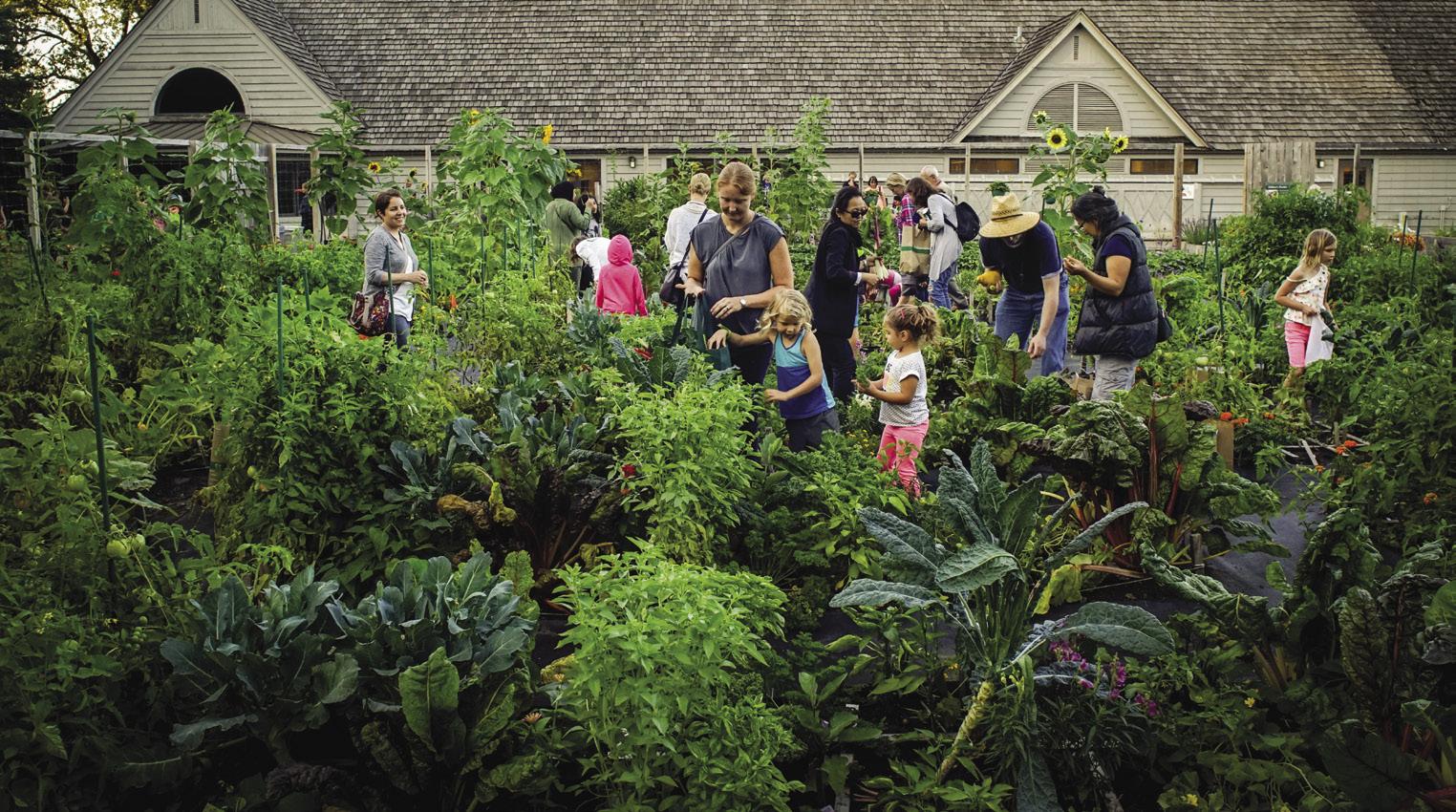
Garden Landscape Photography (Online)
June 27, 6:30-8:30 p.m.
Have you ever wondered how gardens in magazines always look so good? Photography, of course! Learn to capture amazing photos of gardens with techniques, including selective focus, varying points of view, fields of view, panoramas and how to lead the viewer with lines, patterns and color. Cost is $44/$49.

GREEN BEAN FAMILY GARDEN TIME
June 3, June 17, July 8, July 22, activities available 9:30-11:30 a.m.
Ages 5-11, together with an adult, literally dig into nature! Seasonally themed, staffed activity stations provide at-your-own-pace options like scavenger hunts, garden-inspired creative art projects, science exploration and helping with garden tasks. Cost is $10/child/session (adult members free, or included with gate admission for non-members), all supplies included.
June 3 — Seed Party
July 8 — Dirt Detectives & Insect Investigators
June 17 — Leaves Make Food! July 22 — Pollinators & Friends
Watch the Beekeeper at Work
June 8 or 14, 1-1:20 p.m., July 1 or 4, 11-11:20 a.m.
Drop in to get a peek at a day-in-the-life of a beekeeper. Watch — safely from inside the Bee Center — as the beekeeper inspects the Arboretum’s honey bee hives. This event is weatherdependent because bees do not like rain. No advance registration; just show up! Included with gate admission.
Special Access: Honey Bee Hive Inspection
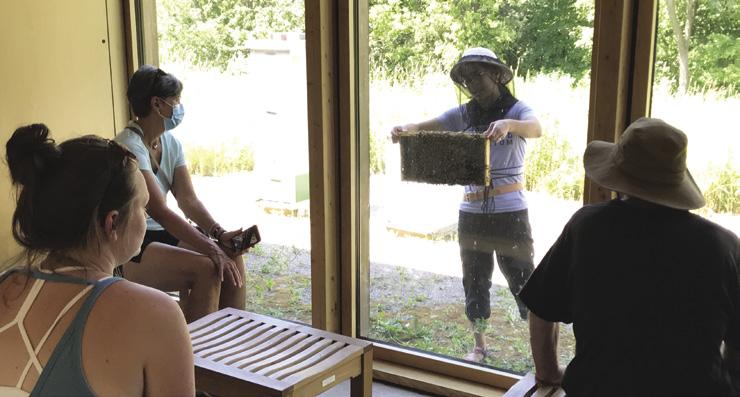
June 16, July 8, or July 16, 10:30-11:45 a.m. or 1-2:15 p.m.
Don a beekeeping suit and join the Arboretum beekeeper at the Tashjian Bee and Pollinator Discovery Center for a close-up look at the inner workings of a honey bee hive. Hold a frame of bees if you dare! Learn about the life of a hive and how we work with these fascinating creatures. Cost is $25/$40.
Macro Nature Photography (Online)
June 20, 6:30-8:30 p.m.
Insightful field notes, technical tips and ethical guidance will have you shooting sharp macro and close-up nature shots in no time. Learn to use lighting, how to freeze motion with flash and shutter speed, techniques for exact focus and controlling focus depth as well as artistic approaches to macro imagery. Cost is $44/$49.
Photographing Butterflies, Moths & Caterpillars (Online)
July 18, 6:30-8:30 p.m.
Learn pro techniques and equipment tips to photograph these skittish creatures. Understanding butterfly behavior, the importance of native host plants, and knowing which photogenic caterpillars to search for can increase your success in getting spectacular shots. Cost is $44/$49.
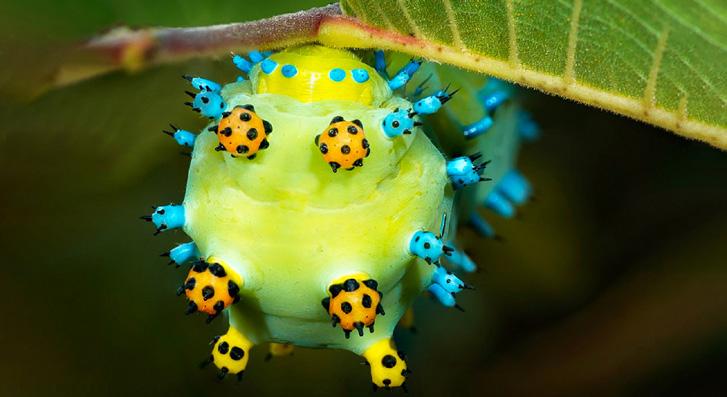
Paint a Portrait of Your Pet
July 22, 10 a.m.-2 p.m.
Paint a portrait of your pet based on a favorite photograph. Receive a pre-sketched image of your pet on an 11” x 14” canvas at the beginning of class, then hands-on instruction will guide you to create your own portrait using acrylic paints. Cost is $79/$94; all supplies included.

World of Pollinators: A Photographer's Field
Guide (Online)
June 13, 6:30-8:30 p.m.
Improve your nature photography by understanding the relationship between plants and pollinators. Seek out and photograph the amazing, tiny wildlife found all around us. Learn why flowers attract pollinators and other insects, techniques for overcoming insect photography challenges and tips for getting in close. Cost is $44/$49.
ARBORETUM MAGAZINE // JUNE • JULY 2023 | 15 LEARN
Photo by Jason Boudreau-Landis
Photo by Don Olson
Photo by Laura Cogswell
Photo by Laura Cogswell
Photo by Karen Campbell
3675 Arboretum Drive
Chaska, Minnesota 55318-9613
Stay in the know!
Follow us on social media.
Art at the Arboretum
OSWALD VISITOR CENTER
Earth, Hand and Fire: A Ceramics Exhibition at the Arboretum

June 3-25
Explore unique works by talented local ceramic artists who all honed their craft at the internationally renowned Northern Clay Center in Minneapolis as part of a program called MN NICE (New Institute for Ceramic Education).
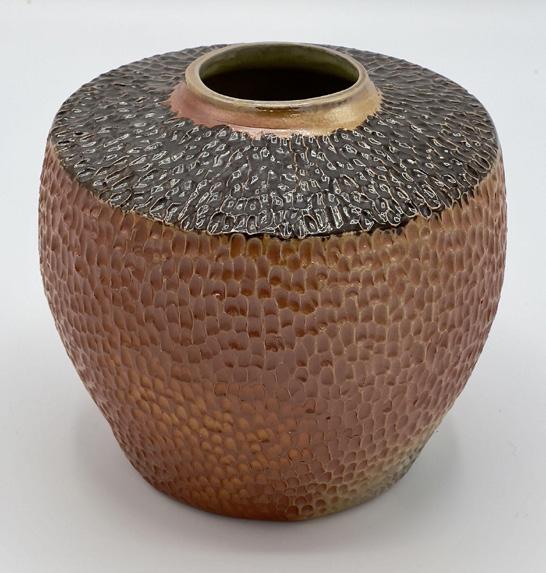
REEDY GALLERY
Ballad of the Blue Heron: The Carved Paintings of Kristen Lowe May 27-Aug. 20

Inspired by countless hours on the Arboretum grounds and in natural areas nearby, artist Kristen Lowe presents this innovative, large-format exhibition, captivating viewers with flora and fauna tucked into dark, yet ethereal landscapes. See story, Page 10.
CAFE GALLERY
Sanctuary: A Batik Journey by Kim Gordon Through June 18
Experience the ancient art of batik, a technique that uses successive layers of liquid pigment and hot wax resist to define color, value and form.
The Landscapes and Flowers of Stephanie Spencer June 22-Aug. 20 Flowers will be blooming inside and out at the Arboretum thanks to Stephanie Spencer’s creations, defined by rich hues and sumptuous images, all made possible with oil paints and a palette knife. Stop by between noon and 2 p.m. on June 24 for an Artist Meet & Greet to chat with Spencer about her inspiration, motivation and techniques.
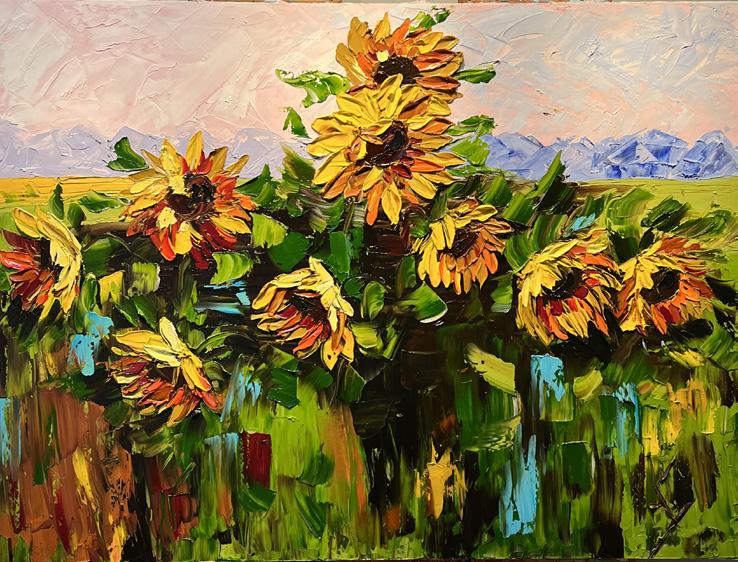
SKYWAY GALLERY
Seasons of Splendor: Illustrations of Japanese Flowers | Through Aug. 12 Revel in the beauty of Japanese floral prints from a four-volume work by Shoseki Kose (1843-1919) titled “Shichijūnikō meika gajō” — which translates as “iIllustrations of Japanese flowers arranged by seasons.”
HARRISON SCULPTURE GARDEN
Dakota Sacred Hoop Walk Opening June 25 | Ongoing
Explore a stunning, five-stop, augmented reality exhibit on the Arboretum grounds by Spirit Lake Dakota artist Marlena Myles. A smartphone and the Revelo AR app are required. Learn more at arb.umn.edu/sacredhoopwalk
Ceramics by Joseph Tashjian (top), “Sunbathers II” by Kim Gordon (middle), “Heavy Heads” by Stephanie Spencer (bottom)













































